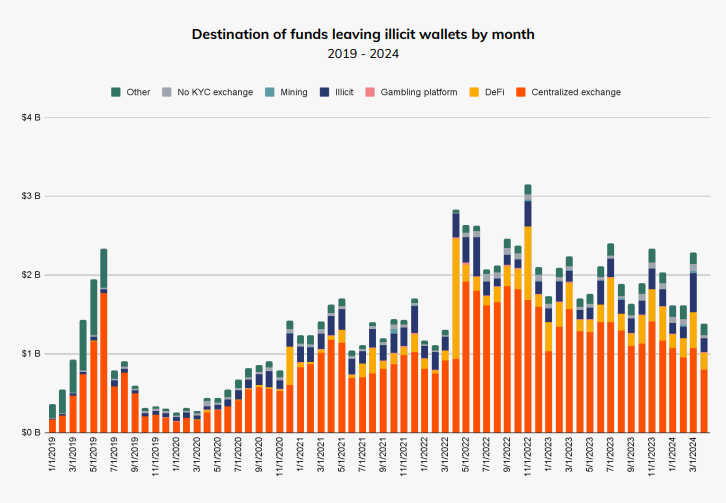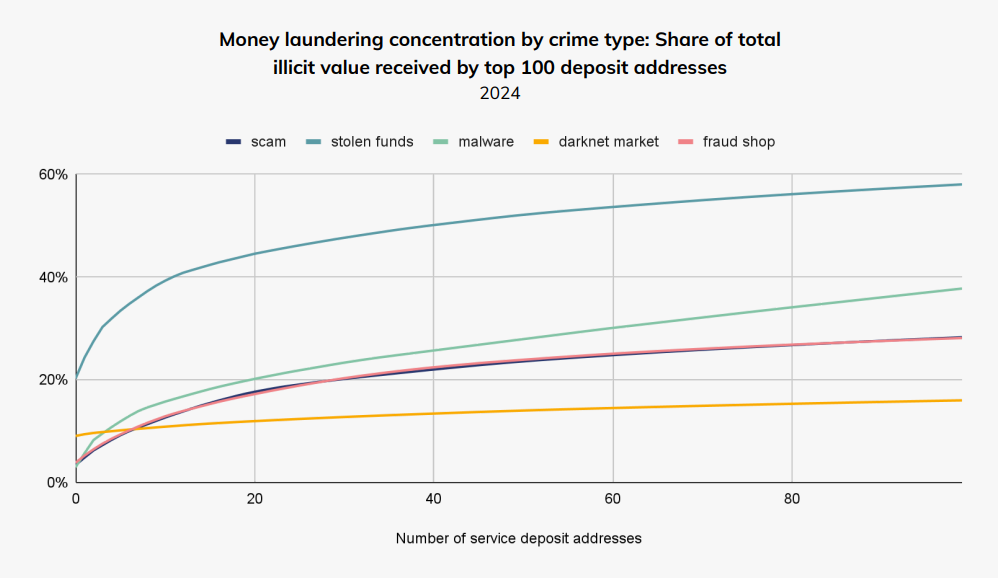
Centralized exchanges receive over 50% of illicit crypto funds: Chainalysis report
Key Takeaways
- Over 50% of illicit crypto funds end up at centralized exchanges, directly or indirectly.
- Stablecoins represent a growing portion of illicit funds in intermediary wallets.
Share this article
Over 50% of illicit crypto funds end up at centralized exchanges, either directly or after obfuscation, according to the “Money Laundering and Cryptocurrency” report by Chainalysis. The report highlights a concentration of illicit funds flowing to just five centralized exchanges, which weren’t mentioned in the document.
Additionally, the five centralized exchanges analyzed in the report registered a surge in conversion for funds from darknet markets, fraud shops, and malware.
“Illicit actors might turn to centralized exchanges for laundering due to their high liquidity, ease of converting cryptocurrency to fiat, and integrations with traditional financial services that help blend illicit funds with legitimate activities,” stated Chainalysis analysts.

Despite the concentration of illicit funds destined on centralized exchanges, they registered a decline in monthly illicit fund volume from nearly $2 billion to approximately $780 million, suggesting improved anti-money laundering (AML) measures.
Moreover, over the counter (OTC) brokers operating without proper Know Your Customer (KYC) procedures have emerged as facilitators for off-ramping illicit funds. The report points out that these brokers can be found all over the world and are difficult to identify, “often requiring a combination of off-chain and on-chain intelligence.”
A small crime community
Among the top 100 deposit addresses, illicit funds obtained through stolen funds represent almost 60% of all their holdings. On the other hand, funds related to payments received in crypto on darknet markets represent the smallest share, staying below 20%.
Notably, Chainalysis found that the top 100 deposit addresses receive at least 15% of all illicit funds across various crime categories, indicating a potentially smaller cybercrime community than expected.

The usage of “spots” is still popular
The report also notes the increasing use of intermediary personal wallets, labeled as “hops”, in the layering stage of crypto money laundering, often accounting for over 80% of the total value in these laundering channels. Chainalysis compares this to using multiple bank accounts and shell companies in traditional money laundering schemes.
Furthermore, stablecoins now represent a growing portion of illicit funds passing through intermediary wallets, which Chainalysis labels as consistent with the fact that these crypto assets account for the majority of all illicit transaction volume.
“This rise in the use of stablecoins likely reflects the overall increase in stablecoin adoption over the last few years — after all, both good and bad actors often prefer to hold funds in an asset with a value that will not change based on swings in the market. But using stablecoins also adds an element of risk for launderers: stablecoin issuers have the ability to freeze funds, which we address later.”
Share this article
Go to Source
Author: Gino Matos










